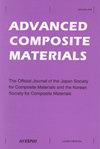Numerical and experimental investigations of low-velocity impact on composite overwrapped pressure vessel with different stacking sequences
IF 2.3
3区 材料科学
Q3 MATERIALS SCIENCE, COMPOSITES
引用次数: 0
Abstract
AbstractComposite overwrapped pressure vessels are designed to contain fluids that operate under high pressures. In addition to internal pressure, the design needs to account for out-of-plane loading in the form of low-velocity impact. In this study, a numerical analysis of four models of composite overwrapped pressure vessels with different stacking sequences is performed. A three-dimensional explicit finite element model using multi-layer stacked shell elements was used in the impact zone region to obtain reasonable computation time. Utilizing the bilinear traction-separation law, cohesive zone elements were used to simulate the delamination failure and as bonding between eight layers of CFRP covering the aluminum liner. The simulation results were then validated using drop-weight impact tests, which revealed that the response of contact force to impact time was comparable for both types of analysis. Prediction of failure was carried out by assessing the quantity of energy absorbed by the CFRP layers and was confirmed by shell element data that failed during simulations. In addition, the Hashin damage model confirmed that the matrix tensile failure mode was the predominant failure mode for all discussed impact scenarios. Model-A with Al + [90]8 stacking sequence was found to have the highest impact resistance based on the prediction of the composite’s failure area and the energy absorbed by the CFRP layers. Furthermore, it was found that COPVs with combinations of helical and hoop sequences tend to have larger areas of delamination due to high interlaminar shear stress between the CFRP layers.Keywords: low-velocity impactcohesive zone elements;Hashin damage model impact energy absorption Disclosure statementNo potential conflict of interest was reported by the author(s).不同堆叠顺序对复合材料包覆压力容器低速冲击的数值与实验研究
摘要复合包覆压力容器设计用于盛装在高压下工作的流体。除了内部压力外,设计还需要考虑低速冲击形式的面外载荷。本文对四种不同堆叠顺序的复合材料包覆压力容器模型进行了数值分析。为了获得合理的计算时间,在冲击区区域采用了多层叠加壳单元的三维显式有限元模型。利用双线性牵引-分离规律,利用黏聚区单元模拟了复合材料的分层破坏,并模拟了复合材料覆盖铝衬里的8层间的粘接。然后通过落锤冲击试验验证了仿真结果,结果表明,两种分析类型的接触力对冲击时间的响应是相似的。通过评估CFRP层吸收的能量进行破坏预测,并通过模拟过程中破坏的壳单元数据进行验证。此外,Hashin损伤模型证实,在所有讨论的冲击场景中,基体拉伸破坏模式是主要的破坏模式。通过对复合材料破坏面积和CFRP层吸收能量的预测,发现Al +[90]8堆叠顺序的a型具有最高的抗冲击能力。此外,由于CFRP层间的高层间剪切应力,螺旋和环箍组合的copv往往具有更大的分层面积。关键词:低速冲击内聚区单元;哈辛损伤模型冲击能量吸收披露声明作者未报告潜在利益冲突。
本文章由计算机程序翻译,如有差异,请以英文原文为准。
求助全文
约1分钟内获得全文
求助全文
来源期刊

Advanced Composite Materials
工程技术-材料科学:复合
CiteScore
5.00
自引率
20.70%
发文量
54
审稿时长
3 months
期刊介绍:
"Advanced Composite Materials (ACM), a bi-monthly publication of the Japan Society for Composite Materials and the Korean Society for Composite Materials, provides an international forum for researchers, manufacturers and designers who are working in the field of composite materials and their structures. Issues contain articles on all aspects of current scientific and technological progress in this interdisciplinary field. The topics of interest are physical, chemical, mechanical and other properties of advanced composites as well as their constituent materials; experimental and theoretical studies relating microscopic to macroscopic behavior; testing and evaluation with emphasis on environmental effects and reliability; novel techniques of fabricating various types of composites and of forming structural components utilizing these materials; design and analysis for specific applications.
Advanced Composite Materials publishes refereed original research papers, review papers, technical papers and short notes as well as some translated papers originally published in the Journal of the Japan Society for Composite Materials. Issues also contain news items such as information on new materials and their processing."
 求助内容:
求助内容: 应助结果提醒方式:
应助结果提醒方式:


